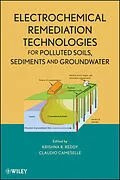An unmatched reference on electrochemical technologies for soil,
sediment, and groundwater pollution remediation
Electrochemical technologies are emerging as important
approaches for effective and efficient pollution remediation, both
on their own and in concert with other remediation techniques.
Electrochemical Remediation Technologies for Polluted Soils,
Sediments and Groundwater provides a systematic and clear
explanation of fundamentals, field applications, as well as
opportunities and challenges in developing and implementing
electrochemical remediation technologies. Written by leading
authorities in their various areas, the text summarizes the latest
research and offers case studies that illustrate equipment,
installation, and methods employed in real-world remediations.
Divided into nine sections, the coverage includes:
* Introduction and fundamental principles
* Remediation of heavy metals and other inorganic pollutants
* Remediation of organic pollutants
* Remediation of mixed contaminants
* Electrokinetic barriers
* Integrated (coupled) technologies
* Mathematical modeling
* Economic and regulatory considerations
* Field applications and performance assessment
Unique as a comprehensive reference on the subject,
Electrochemical Remediation Technologies for Polluted Soils,
Sediments and Groundwater will serve as a valuable resource to
all environmental engineers, scientists, regulators, and
policymakers.
Autorentext
Krishna R. Reddy is Professor of Civil and Environmental Engineering at the University of Illinois at Chicago (UIC). Dr. Reddy received his PhD in Civil Engineering from the Illinois Institute of Technology, Chicago. He received gold medals for being first in his class of BS (Civil Engineering) at Osmania University and MS (Civil Engineering) at the Indian Institute of Technology, Roorkee. His teaching and research expertise includes remediation of contaminated sites, waste containment systems, and beneficial reuse of waste/recycled materials. His research contributed to the understanding of fundamental geochemical processes and development of integrated electrochemical technologies to remediate contaminant mixtures. He is the coauthor of Geoenvironmental Engineering: Site Remediation, Waste Containment, and Emerging Waste Management Technologies, also published by Wiley.
Claudio Cameselle is Associate Professor in the Department of Chemical Engineering at the University of Vigo, Spain. He received his undergraduate degree and his PhD in chemistry at the University of Santiago de Compostela, Spain. He then moved to the University of Vigo, where he has been working as a faculty member for the last fourteen years. He spent a sabbatical year as visiting professor at the University of Illinois at Chicago in 2008. His teaching activities are in the areas of chemical engineering and environmental engineering. In recent years, his research activity has focused on the development of electrokinetic remediation for the treatment of soils and sludges polluted with heavy metals and organics.
Klappentext
An unmatched reference on electrochemical technologies for soil, sediment, and groundwater pollution remediation
Electrochemical technologies are emerging as important approaches for effective and efficient pollution remediation, both on their own and in concert with other remediation techniques. Electrochemical Remediation Technologies for Polluted Soils, Sediments and Groundwater provides a systematic and clear explanation of fundamentals, field applications, as well as opportunities and challenges in developing and implementing electrochemical remediation technologies. Written by leading authorities in their various areas, the text summarizes the latest research and offers case studies that illustrate equipment, installation, and methods employed in real-world remediations.
Divided into nine sections, the coverage includes:
-
Introduction and fundamental principles
-
Remediation of heavy metals and other inorganic pollutants
-
Remediation of organic pollutants
-
Remediation of mixed contaminants
-
Electrokinetic barriers
-
Integrated (coupled) technologies
-
Mathematical modeling
-
Economic and regulatory considerations
-
Field applications and performance assessment
Unique as a comprehensive reference on the subject, Electrochemical Remediation Technologies for Polluted Soils, Sediments and Groundwater will serve as a valuable resource to all environmental engineers, scientists, regulators, and policymakers.
Inhalt
PREFACE.
CONTRIBUTORS.
PART I Introduction and Basic Principles.
1 Overview of Electrochemical Remediation Technologies (Krishna R. Reddy and Claudio Cameselle).
1.1. Introduction.
1.2. Electrochemical Technologies for Site Remediation.
1.3. Electrochemical Transport, Transfer, and Transformation Processes.
1.4. Electrochemical Removal of Inorganic Pollutants.
1.5. Electrochemical Removal of Organic Pollutants.
1.6. Electrochemical Removal of Contaminant Mixtures.
1.7. Special Considerations in Remediating Polluted Sediments.
1.8. Electrokinetic Barriers for Pollution Containment.
1.9. Coupled (or Integrated) Electrochemical Remediation Technologies.
1.10. Mathematical Modeling of Electrochemical Remediation.
1.11. Economic and Regulatory Considerations.
1.12. Field Applications and Lessons Learned.
1.13. Future Directions.
References.
2 Electrochemical Transport and Transformations (Sibel Pamukcu).
2.1. Introduction.
2.2. Overview.
2.3. Electrochemical Transport in Bulk Fluid.
2.4. Electrochemical Transport in Clays in the Direction of Applied Electric Field.
2.5. Electrochemical Transformations.
2.6. Summary.
References.
3 Geochemical Processes Affecting Electrochemical Remediation (Albert T. Yeung).
3.1. Introduction.
3.2. SoilFluidChemical System as Active Electrochemical System.
3.3. Generation of pH Gradient.
3.4. Change of Zeta Potential of Soil Particle Surfaces.
3.5. Change in Direction of Electroosmotic Flow.
3.6. Sorption and Desorption of Contaminants onto/from Soil Particle Surfaces.
3.7. Buffer Capacity of Soil.
3.8. Complexation.
3.9. OxidationReduction (Redox) Reactions.
3.10. Interactions of Geochemical Processes.
3.11. Summary.
References.
PART II Remediation of Heavy Metals and Other Inorganic Pollutants.
4 Electrokinetic Removal of Heavy Metals (Lisbeth M. Ottosen, Henrik K. Hansen, and Pernille E. Jensen).
4.1. Introduction.
4.2. Principle of EK Removal of Heavy Metals from Soils.
4.3. Heavy Metal and Soil Type.
4.4. Enhancement Methods.
4.5. Remediation of Mine Tailings, Ashes, Sediments, and Sludge.
4.6. Summary.
References.
5 Electrokinetic Removal of Radionuclides (Vladimir A. Korolev).
5.1. Introduction.
5.2. Electrokinetic Localization of Radioactive Nuclide Pollution.
5.3. Electrokinetic Cleaning of Ground from Radioactive Nuclides.
5.4. Summary.
References.
6 Electrokinetic Removal of Nitrate and Fluoride (Kitae Baek and Jung-Seok Yang).
6.1. Introduction.
6.2. Pollution and Health Effects of Anionic Pollutants.
6.3. Removal of Anionic Pollutants by Electrokinetics.
6.4. Summary.<…
